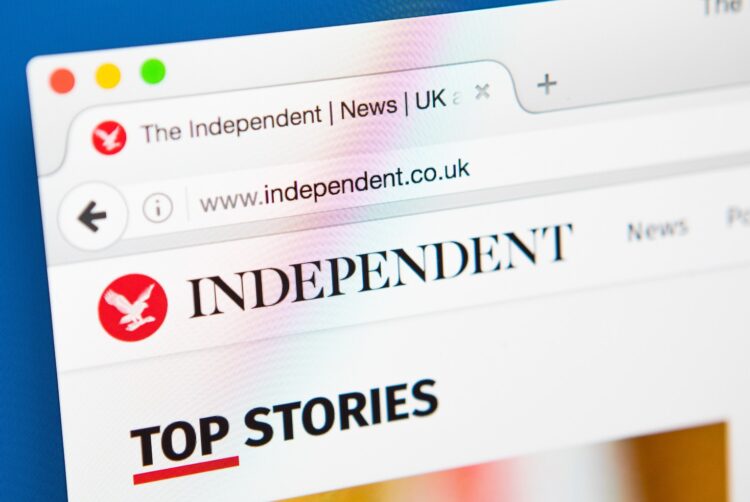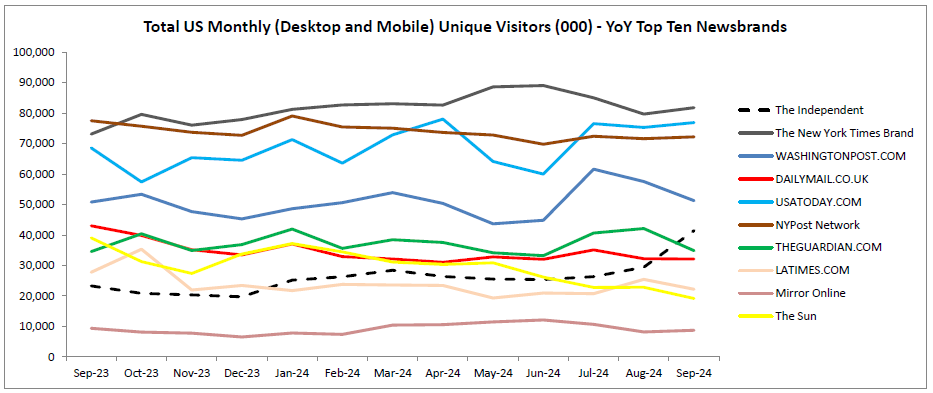Independent’s US audience more than doubles in election year

The Independent has more than doubled its US audience this year to reach 41.4m, according to September Comscore figures.
US consumption at the digital-only news outlet grew by 21.7m new readers (+110%) in the first nine months of the year. The site is now generating over 5.4 times the number of monthly page views it was getting at the end of 2023.
As a result, The Independent has overtaken both The Guardian (34.8m) and MailOnline (32.1m) as the biggest British-born news site in the US, based on Comscore’s measure of monthly unique desktop and mobile users.
By the same online-only measure, The Independent is now the fifth-most-read digital news brand in the US, behind the digital offshoots of The New York Times, USA Today, the New York Post and The Washington Post.

Figure: Comscore (September 2024)
“In a crucial year for democracy, when America seeks truth and trust, more people than ever are turning to The Independent,” said CEO Christian Broughton.
“Our readers are more conscious than ever of their media choices. We were founded specifically to cut through political polarisation, report the facts and let our readers decide, and they have told us this is exactly what they value.”
Editorial investment paying off
The Independent has invested aggressively in the US this year as leaders at the title sought to take advantage of interest in the closely contested US presidential election race, which concludes on Tuesday.
This year alone, the outlet has grown its US editorial staff by 40%. Key hires have included ex-DailyMail.com editor Louise Thomas, who was poached in March to become US editor; ex-Daily Beast senior breaking news editor Danika Fears, who joined as US head of news in May; and ex-DailyMail.com assistant editor Alex Lang, who joined as US deputy news editor in the same month.
Editor-in-chief Geordie Greig called the Comscore figures a “triumphal moment for the US team”.
He added: “We are grateful to all our readers in America for putting their faith in The Independent at a time when independent journalism has never been more needed.”
The Independent has also this year invested in a new URL for US audiences — the-independent.com — with the aim of highlighting its US-specific coverage as the editorial team looks to build out new lifestyle verticals for readers.
The Independent’s CEO eyes publisher partnerships beyond BuzzFeed
Former Independent CEO Zach Leonard, who was appointed global chief operating officer and president, North America, in October 2023 with a remit of growing the US business, commented: “The scale of The Independent’s US audience — and its quality of discerning, active and passionate readers — are increasingly meeting the demand and targeting goals of our partners, advertisers and clients.
“Following decades of persistent investment, technology and talent building, we’re now competing across the full range of quality US digital news brands.”
Other UK publishers have in recent years also attempted to tap US audiences to grow web traffic. These include The Guardian, Reach’s Mirror and Express, and News UK’s The Sun.
Analysis: Americans testing alternatives
In an interview with The Media Leader in the summer, Broughton said the US was a major growth pillar for the news brand, adding that business across the pond was performing “above budget”.
He pointed to the site’s penchant for “characterful” headlines as a point of difference from established US brands, noting: “There’s a certain kind of conservativeness with US news presentation sometimes.”
Criticism of major US newspapers has grown amid the election year. According to a Gallup poll in October, just 31% of Americans say they trust the news media, with a clear partisan splintering occurring since Donald Trump was elected president in 2016. Today, just 12% of registered Republicans say they trust the news media, compared with 54% of Democrats and 27% of independents.
While a majority of Democrats say they trust the news media, criticism from the political left has become more prominent this year amid accusations that major newspapers and broadcasters have “sanewashed” Trump by portraying him as less incoherent in his public remarks than is the case. Critics have also accused the press of applying an unfairly low standard to Trump’s conduct compared with vice-president Kamala Harris.
The criticism has prompted frank internal meetings at institutions such as The New York Times over whether it should change its coverage or tone, although executive editor Joseph Kahn has reportedly remained unswayed.
Meanwhile, concern over an appearance of conflict of interest for newspaper owners crescendoed recently when the owners of the Los Angeles Times and The Washington Post — billionaires Patrick Soon-Shiong and Jeff Bezos respectively — both interfered with their editorial teams to stop planned endorsements for Harris.
The great newspapers of the world just lost a couple of members
The deepening sense of grievance by some on the left has opened doors for competitors seeking audiences that have become jaded by journalistic output in the US.
That includes major British news brands, which have sought to capitalise on the lucrative US market by offering distinctive and at times openly slanted news coverage.
The Guardian US, for example, earned $2m off the back of a single well-timed marketing email sent by US editor Betsy Reed after Bezos’ intervention at The Washington Post became public.
“It has never been clearer that media ownership matters to democracy,” Reed’s email reads. “The Guardian is not billionaire-owned, nor do we have shareholders. We are supported by readers and owned by the Scott Trust, which guarantees our editorial independence in perpetuity.
“A Guardian editorial strongly endorsed Kamala Harris for president earlier this week — and we are unafraid of any potential consequences.”
Major investors in The Independent include Evgeny Lebedev, son of Russian oligarch Alexander Lebedev; Saudi investor Sultan Muhammad Abuljadayel; and media entrepreneur Justin Byam Shaw.
The title was founded in 1986 with a non-partisan ethos; in 2016, it became the first major UK newspaper to move to a digital-only model.




